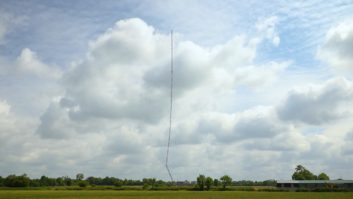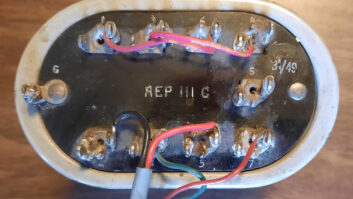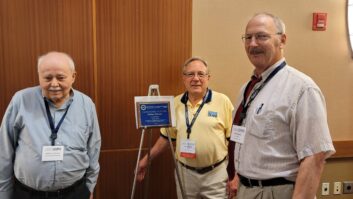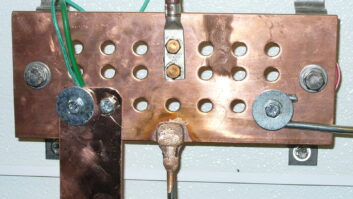Tall AM towers
Jul 1, 2001 12:00 PM, By John Battison, P.E., technical editor, RF
Usually, bigger is better. But in the case of AM towers, taller is not always better. A very tall AM radiator is not always the best radiator. In fact, without a considerable amount of expensive work, it’s not possible to successfully use a tower over ? wavelength (0.625l), and the FCC would probably not accept it on the grounds of low efficiency.
The one-quarter wavelength (�, 0.25l or 90�) AM radiator is generally the most popular today. Its electrical length lends itself to easier calculations and efficient radiation. As AM antenna length (height) increases, radiation efficiency improves until we reach about 0.53l. Radiators taller than 0.53l have a slightly higher radiation efficiency, but at the cost of an often unwanted high angle lobe at about 60� for a maximum efficiency length of 0.625l (or ?l), as shown in Figure 1.
Figure 1. The effect of antenna height on the angle of lobe radiation. enlarge
Figure 2. Radiation pattern of an antenna longer than one wavelength. enlarge
Figure 3. High angel signales cause skywave interference to the groundwave. enlarge
Figure 4. Stacking two half-wavelength radiators normally produces a phase-cancelled signal. enlarge
Daytimers with a 0.625l tower can usually disregard the 60� high-angle lobe, because it is not often that daytime ionospheric reflections produce interference. But it is essential to examine the situation if night and/or critical hour protection is required. Nighttime operation using a directional antenna involves careful manipulation to reduce high angle radiation, and unless a strong skywave signal is required at a convenient distance, 0.625l towers are not widely used.
FM towers for AM
In the early days of FM, and later television development, some AM stations that obtained construction permits erected tall towers for their new FM or TV operation and hoped to use them for AM as well. In many cases, the towers were too tall for AM use without electrical modification; this had to be planned prior to construction.
A horizontal long antenna of 1l or more will have a rather useless radiation pattern (Figure 2). Lobes of radiation will spring from the antenna at various azimuths and not provide adequate coverage. Shorter horizontal antennas will have the familiar figure-eight pattern from the sides. A vertical long wire antenna of 1l would transmit most of its power skyward and would produce horrendous skywave interference and little ground wave signal.
There are several long antennas that are very interesting but do not have a modern application to AM work. Among these, the Polyrod antenna is an excellent illustration of radiation from a non-metallic device with a reasonable gain and directivity. Unfortunately, it is only usable for microwave purposes because it needs to be several wavelengths long, and even for UHF work the size would be too great. However, it does fall into the region of long antennas. The tapered antenna is fed by a short piece of waveguide and performs as an endfire antenna. Dimensions are several wavelengths long and about 0.5l in diameter, reducing to about 0.3l.
There is, however, one type of tall AM antenna that has existed for a long time: the Franklin Antenna. Unhappily, few are constructed these days, probably because of the FAA’s dislike of tall structures, cost and the lack of suitable interference/allocation clearance to take advantage of the increased service contour. It was also known as an anti-fading antenna.
Many AM stations produce interference and fading signals to themselves. The Franklin anti-fading antenna was designed to eliminate or reduce these problems. A taller antenna can be used to obtain greater groundwave coverage. Unfortunately, there would often be large areas that received either interference or fading/distorted signals due to excessive skywave signals.
The interfering skywave signal was the station’s own reflected skywave signal returning to earth near the further reaches of usable groundwave coverage where the skywave was stronger than the groundwave and ground conductivity was high. See Figure 3. The 60� antenna lobe was the cause, rather like a cow standing on its own tail.
More about Franklins
It was known that a half-wave radiator provided excellent radiation characteristics. So the thought was why not have two half-wave radiators mounted one above the other? In other words, a full wave antenna. Unfortunately, full wave antenna current distribution produces two half-wave lobes with out of phase currents (and voltage), as shown in Figure 4a. This results in poor horizontal radiation and excessive high angle signals, as mentioned earlier.
The Franklin antenna consists of two half-wave radiators mounted one above the other and insulated from each other. The lower radiator base is insulated in the usual way. The transmission line is run up inside the lower section, mounted on insulators and out of the induction field. At the insulated space between the two towers, a phasing network is mounted. This changes the phase relationships so that the currents in each half-wave section are in phase (see Figure 4b), and the efficiency of two half-wave radiators is realized in terms of increased ground wave and decreased high angle signals.
Many years ago, an unusual directional combination of a tall antenna and a vertical drop wire was authorized for a 50kW station, and could be again under the proper circumstances. The upper and lower elements of the antenna were driven through a modified phasor, which also controlled a single drop wire suspended from a guy wire. Each of the three antenna elements was monitored by a standard monitor loop and antenna monitor and handled like a regular directional antenna operation.
The installation ran for many years and was generally satisfactory. One troublesome problem was caused by weather affecting the mutual impedance at the center of the tower where the phasing circuit was located. This made it difficult to maintain the licensed operating parameters for the array. Eventually, allocation/interference conditions made it possible to operate with a slightly shorter, regular AM tower, and the DA section was dismantled.
There are several variations of the symmetrical vertical divided radiator in use. By changing the ratio of the lengths of the two vertical sections, it is possible to control, to a limited extent, the vertical radiation pattern, and hence the high angle interfering signal. The almost limitless ability of computers makes it possible to fully model the important characteristics of such an antenna. In the past, it was necessary to make costly helicopter measurements to satisfy FCC requirements.
In view of tower construction costs today and the scarcity of suitable sites, as well as opposition by many groups to tall towers, it is not surprising that most AM operators stick to the tried-and-true 90� tower for most installations. Its performance is well documented, and it is easier to handle in calculations; although, in these days of universal computer availability, ease of calculation is probably one of the least important considerations.
E-mail John at[email protected].












